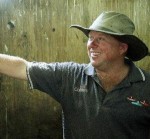Deer get marching orders
PATRICK O’SULLIVAN | Thursday, February 2, 2012 9:01
CHANGE OF TACK: Stephen Baker will miss farming deer as he expands his Southdown sheep stud. Stephen Baker of Omakere is selling his herd of red deer to concentrate on his Te Mara Southdown Stud as demand rises for a breed that has evolved to suit Hawke’s Bay conditions.
“I can’t seem to make enough of them,” he said.
“Southdown has changed a bit to how it used to be. Everyone thought you’d get a lot of fats out of a Southdown but you don’t – they grade well and you get more.
“For those pre-Christmas early lambs the old Southdown is great. Straight off mum they yield better – I’ve got guys killing 3-month-old milk lambs off mum at 18-19kg [yield].
“They seem to like the dry country and Hawke’s Bay is renown to be a bit dry.”
He said rams were reported to last longer and the fast growth made for less work.
“Most of them are gone before its time to shear.”
Fleeces are considered medium wool type with a fibre diameter of 23.5 to 29.0 microns.
“They’re not a wool sheep they’re a fat lamb sheep.”
He will sell his 200 hinds over the next over two years.
“Most are sold privately through an agent but there is an annual deer sale in Taihape.”
He said he will be sad to see the deer go.
“I do enjoy them – they’re different to work than a lot of stock. Some days you can go out and it only takes 10 minutes to move them, other days they give the run-around.
“You either love them or you hate them. They’re harder on your dogs, they’ll chase them, especially at the first muster after fawning because they are protecting their baby – they box the dogs with their front feet.”
The danger of working alone with the large flighty deer in he yards is another reason to quit.
“Sheep don’t jump on you.”
“The odd one will get up and clout you with their front feet in the shed but I just get rid of them. I’m in the deer shed by myself so I can’t afford to be hit.
“But they are an interesting animal. If you come out at night and see the fawns playing on these faces – man can they scoot. They are a beautiful animal to watch.
His deer paddocks have long grass for fawning, which finished in January.
“If your fawns haven’t got any cover to hide in like this long grass, then they’ll go and poke around and look to hop through the fences – they don’t need much of a hole.”
He shoots wild venison that are attracted to his herd.
“You do get the odd wild one but it’s not really stalking, they are just standing on the fence. Hunting is when you go into the bush.”
Wild deer have to be kept away from his herd to protect its TB-free status. The herd is tested every three years, requiring their necks to be shaved before a test injection from a vet.
He said venison was a far superior meat when cooked right and it was a shame it had not been marketed better in New Zealand.
Daughter Tiffany said the venison cooked by her dad was always the first to be eaten at their barbecues.
Most venison is exported.
Despite his enjoyment of the deer, his 453ha farm has to be treated as a business if it is to continue to succeed.
“I’ll make twice as much money on the Southdown as I do on the deer,” he said.

